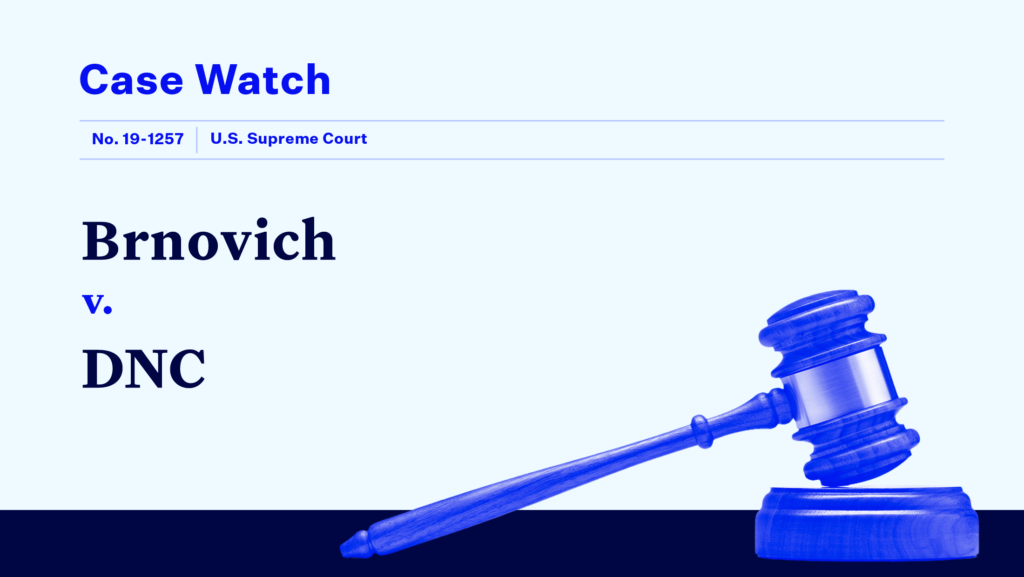Arizona Ballot Collection and Out-of-Precinct Ballots

On Tuesday, March 2, 2021, the U.S. Supreme Court will hear the most important voting rights case of the term: Brnovich v. Democratic National Committee. The lawsuit is over five years in the making, exemplifying exactly how much further we have to go in the fight against disenfranchisement
How did we get here?
In 2013, when the Supreme Court struck down the heart of the Voting Rights Act (VRA) in its Shelby County v. Holder decision, Arizona was suddenly released from the “preclearance” requirement. Before Shelby, Section 5 of the Voting Rights Act had required states with a history of suppressing minority voters — like Arizona — to receive preclearance from the U.S. Department of Justice or the U.S. District Court for the District of Columbia before changing any of the state’s voting laws.
The result? In less than three years, Arizona “created a culture of voter disenfranchisement” by passing strict election laws that suppressed voters across the state, and which fell especially hard on minority voters.
One of these laws, passed in 2016, made it a felony to return someone else’s signed and sealed ballot. This practice — also known as ballot collection — was particularly popular among the Latino community, who often have activists assist them by collecting their ballots during the get-out-the-vote period, and by Native Americans, many of whom live on rural tribal lands and lack easy access to a mailbox or post office. However, Republicans in the state had rallied against ballot collection after the former head of the Maricopa County Republicans spread an “inaccurate” and “racially tinged” video that falsely accused a Hispanic man of dropping off fraudulently “harvested” ballots.
Arizona also disenfranchised voters at alarming rates through its provisional balloting process. A provisional ballot is different from a regular in-person ballot and is used when an election official can’t immediately determine if a person is eligible to vote. The issue with provisional ballots is that a provisional ballot will only be counted if election officials decide after the polls close that the person is an eligible voter.
Arizona leads the nation in rejecting ballots that were cast in the wrong precinct. Finding the correct precinct is particularly difficult in Arizona, where polling locations change with great frequency and the population has one of the highest moving rates in the country. Moreover, the penalty for voting out-of-precinct is severe: complete disenfranchisement. Unlike many other states, Arizona does not attempt to count the races for which the voter was eligible — for instance, statewide or federal races — but instead rejects the entire ballot. Minority voters are disproportionately impacted: they are twice as likely as Caucasian Arizonans to vote in the incorrect precinct.
In April 2016, the Democratic National Committee (DNC), Democratic Senatorial Campaign Committee (DSCC), Hillary for America, a U.S. Senate campaign, the Arizona Democratic Party and individual voters challenged these two regulations. The lawsuit claimed that the out-of-precinct voting regulations and the ban on ballot collection have “a disparate effect on Hispanic, Native-American, and African-American voters in violation of Section 2 of the Voting Rights Act.”
Section 2 of the VRA protects minority groups from discriminatory voting laws and practices. The DNC’s lawsuit presented extensive evidence showing that both the ballot collection ban and out-of-precinct regulations disproportionately burdened minority voters in Arizona.
In January of last year, the en banc 9th U.S. Circuit Court of Appeals agreed and struck down both regulations. The court found that the ballot collection ban was specifically created to disenfranchise minority voters, writing:
Arizona’s long history of race-based voting discrimination; the Arizona legislature’s unsuccessful efforts to enact less restrictive versions of the same law when preclearance was a threat; the false, race-based claims of ballot collection fraud used to convince Arizona legislators to pass H.B. 2023; the substantial increase in American Indian and Hispanic voting attributable to ballot collection that was targeted by H.B. 2023; and the degree of racially polarized voting in Arizona—cumulatively and unmistakably reveal that racial discrimination was a motivating factor in enacting H.B. 2023.
As for the out-of-precinct regulation, the court found similar suppression of minority voters, saying,
Arizona’s practice of wholly discarding OOP ballots thus has the effect of disproportionately undercounting minority votes, by a factor of two to one, precisely where the problem of under-representation in Arizona is most acute.
However, just before the 2020 elections began, Republicans appealed this major voting rights victory to the Supreme Court.
What’s at stake?
When the Supreme Court hears oral argument on March 2, it will not just be another case about how to interpret a statute. The court will consider the scope of the most important provision of law protecting minority voting rights — Section 2 of the VRA. Since the Supreme Court’s decision in Shelby that gut Section 5 of the VRA, the voting rights community has been forced to increasingly rely on Section 2 and the protections it affords minority voters. The decision in this case will not just impact Native American, Latino and Black voters’ right to cast and have their ballots counted in Arizona, but will set a nationwide precedent.
At a time when minority voting rights are under attack by Republican legislatures around the country, the outcome of this case will either expand or limit the tools available to those fighting voter suppression in court. It could also impact the scope of Section 2’s protections as we enter a crucial redistricting cycle. In short, the stakes could not be higher. A strong VRA is necessary to protect minority voters’ right to cast their ballots and have them counted.